

FEELING REJUVENATED WITH CBD
Everyone feels the hurt as we age, but CBD can help you deal with it
By: Beth Giles
Life really does fly by. Before I knew it, my 60s had arrived, and with them came some new gifts from dear ol’ Mother Nature—frequent knee pain, stress, low energy and sleeplessness. Now, I’m a realist about these things, I knew I wasn’t going to be young and springy forever. But still, with “golden years” nearly on my doorstep, I couldn’t help but feel a little cheated. That is until I found my own secret weapon. Another gift from Mother Nature.
It began a few months back when I was complaining about my aches and pains to my marathon-running granddaughter, Jen. She casually mentioned how she uses CBD rub to help with her joint pain. She said that CBD gave her more focus and clarity throughout the day and that her lingering muscle and joint discomfort no longer bothered her. She even felt comfortable signing up for back-to-back marathons two weekends in a row this year. That made even this self-proclaimed skeptic take notice.
But I still had some concerns. According to one study in the Journal of the American Medical Association, 70% of CBD products didn’t contain the amount of CBD stated on their labels. And, as a consumer, that’s terrifying! If I was going to try CBD, I needed to trust the source through and through. My two-fold research process naturally led me to Zebra CBD. First, I started calling my family and friends. Call me old fashioned but I wanted to know if
there were people whom I trusted (more than anonymous testimonials) who’ve had success using CBD besides my granddaughter.
Secondly, I wanted cold hard facts. Diving deep into the world of CBD research and clinical studies, I came across Emily Gray M.D., a physician at the University of California at San Diego (UCSD) Medical School and medical advisor to Zebra CBD who is researching the effects of CBD. Dr. Gray wrote “early results with CBD have been promising and we have a lot of research underway now. I’ve had several patients using CBD with good success. It’s important that you know your source of CBD and how to use it properly.”
After hearing it from the doctor’s mouth, I returned to my research, asking more people and was amazed by the number of close friends and family who were already on the CBD train. Apparently, I was the only one without a clue! And funny enough, a couple of friends who commented were using the same brand as my granddaughter—Zebra CBD. There was no consensus as to why they were using CBD, but the top reasons given were for muscle & joint discomfort, mood support, sleep support, stress and headaches, as well as supporting overall health & wellness.
Eventually, even the most skeptical of the bunch can be won over. With a trusted CBD source in mind, I decided to give it a go.
When I viewed Zebra CBD’s selection online, I
was impressed by its array of products, including CBD oils called tinctures, topicals, chewable tablets, mints and gummies. After reading on their website that all their products are made with organically-grown hemp, I ordered... and it arrived within 2 days!
The first product I tried was the Rub. Now this stuff was strong. Immediately after rubbing it on my knee, the soothing effects kicked in. It had that familiar menthol cooling effect, which I personally find very relieving. And the best part is, after two weeks of using it, my knee pain no longer affected my daily mobility.
The Zebra Sleep Gummies, on the other hand, had a different but equally positive effect on my body. To take it, the instructions suggest chewing thoroughly. This was simple enough, and the taste was, well, lemony. After about 15 minutes, a sense of calm came over my body. It's hard to describe exactly; it's definitely not a "high" feeling. It's more like an overall sense of relaxation—and then I was out. Needless to say, I slept great and woke up refreshed. I haven’t slept like that in a long time.
While it hasn’t been a catch-all fix to every one of my health issues, it has eased the level and frequency of my aches. And it sure doesn’t seem like a coincidence how rejuvenated I feel. All-in-all, CBD is one of those things that you have to try for yourself. Although I was skeptical at first, I can safely say that I’m now a Zebra CBD fan and that I highly recommend their products. Also, I managed to speak with a Zebra CBD spokesperson willing to provide an exclusive. If you order this month, you’ll receive $10 off your first order by using promo code “RL10” at checkout. Plus, the company offers a 100% No-Hassle, Money-Back Guarantee. You can try it yourself and order Zebra CBD at ZebraCBD.com/CM or at 1-888-762-2699.
Oregon Trail Electric Cooperative 2024 Board of Directors Election Voter Guide
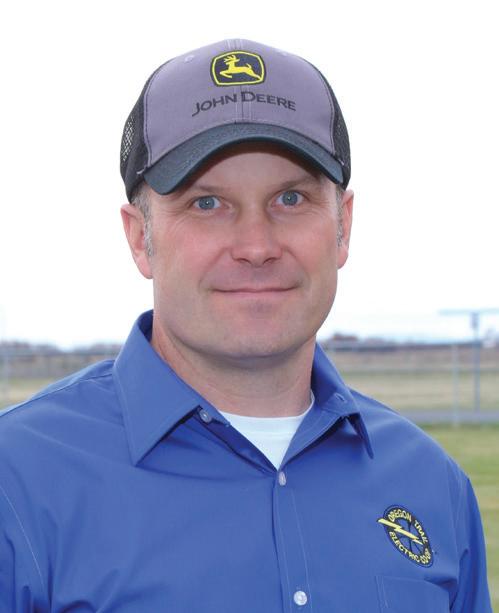
G. Austin Bingaman
Position 4
Union County
Family: Wife, Jeana; children, Isaac and Claira.
Occupation: Farmer in the Grande Ronde Valley, growing grass seed, alfalfa hay, grass hay, small grains, canola, camelina, safflower, and retail bluegrass sod. Owner White Barn Estate. Owner Seed2Crop Premium Sod. Owner
Seed2Crop Precision Planting. Education: Imbler High School; University of Idaho, B.S. mechanical engineering; National Rural Electric Cooperative Credentialed Cooperative Director Program. Organizations: 12 years on the OTEC board. Orodell Ditch Association Board of Directors (president).
Coop Member Tri-County Equipment that provides agriculture supplies and John Deere equipment in Union, Wallowa and Baker counties.
Issues the board of directors will need to deal with: OTEC Board of Directors face challenges throughout every year. We are constantly trying to make sure we have the most cost effective and reliable electrical system available to our members. Vegetation management, Bonneville Power Administration contracts, wildfire mitigation, economic development, and legislative issues are some of the many issues we must deal with.
Statement to voters: Oregon Trail Electric Cooperative is a vital piece to our regions foundation. Having a reliable and affordable source of electricity is the backbone for growth and sustainability for our area. It is important to me that OTEC is a good neighbor and member of our communities. With your continued support I will make it my goal to get the greatest return on investment to you, our members. I look forward to the challenges ahead and ask for your vote during the upcoming election. Thank you for your time and consideration. n
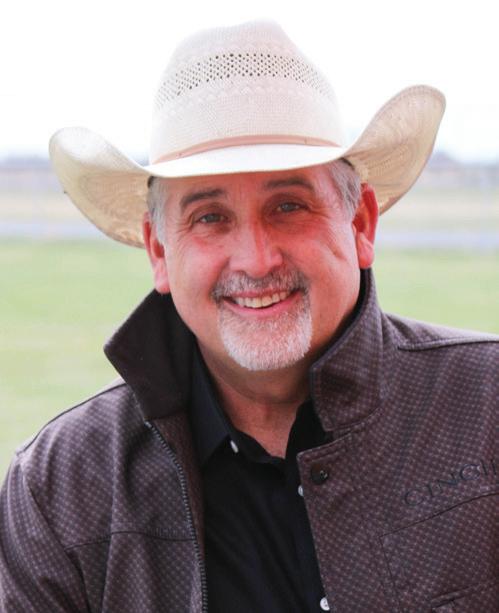
Wayne Overton Position 5 Baker County
Family: Son Ethan Overton and daughter Tawnie Overton.
Occupation: Self-employed general contractor specializing in ag buildings and custom homes. Cattle rancher; manage family ranch. Auctioneer; part time with JBS Auctions, Homedale, Idaho.
Education: Dayville High School.
Public offices held: Current OTEC board member, since 2015; secretary/treasurer of the OTEC board, 2 years; vice president of the OTEC board, 2 years; president of the OTEC board, 2 years; board of directors for ORECA statewide, serving my 3rd year.
Organizations: Member of Oregon Cattleman’s Association. Auctioneer for Younglife (approximately 14 years). Auctioneer for Ducks Unlimited.
Issues the board of directors will need to deal with: Ever changing state and
federal policies impacting BPA. Advancements in solar or battery storage capabilities. Continue fighting rising costs. Fire mitigation.
Statement to voters: Eastern Oregon has been where I spent most of my life. I love Northeast Oregon and everything it has to offer. That is why I am seeking a 4th term as board director for OTEC (Baker County). I believe that a reliable uninterrupted supply of power is vital to our economy and livelihood here in Eastern Oregon. With fossil fuels on the rise again, it is imperative for us here in the Pacific Northwest to continue to fight for one of the greatest hydro power systems in the world, BPA.
Since all of us just went through a very stressful year of uncertainty, both personally and economically, I believe it is very important for us as a co-op to provide stability, by continuing to keep rates as low as possible. I would like to continue to serve as your voice on the board, to be able to communicate a better understanding of how we work for you, the members.
I am especially proud of the work that OTEC has done with our amazing scholarship programs and also teaming up with the Dolly Parton Foundation, providing a pathway for literacy to our youth.
Please vote for me, Wayne Overton, board position 5, Baker County. n
OREGON TRAIL ELECTRIC COOPERATIVE
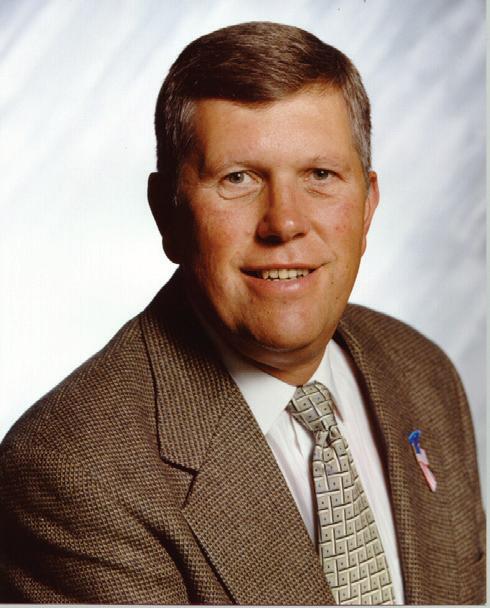
Gary E. Miller
Position 6
Grant County
Family: Wife, Virginia.
Occupation: Retired.
Education: Grant Union High School, John Day. Eastern Oregon University, bachelor of science.
Experience: Retired general manager, Oregon Telephone Corporation (1990-2006). Credential Cooperative Director, board leadership and Gold Director Credential series of courses which provide additional skills and knowledge for cooperative directors.
Organizations: National Rural Electric Cooperative Association. Blue Mountain Hospital Board of Directors (1985-1990); chairman of the board (1986-1990); Grant County Sheriff’s Posse, past captain; Grant School District #3, director (1997-2005); John Day Elks Lodge #1824 (1970-present); past exalter ruler (1985-86); prior trustee for Oregon State Elks Assn.; Disabled American Veterans’ van to Boise and Burns, volunteer driver.
Statement to voters: Having lived in Grant County all my life, I would like to continue to represent the members of OTEC in Grant County
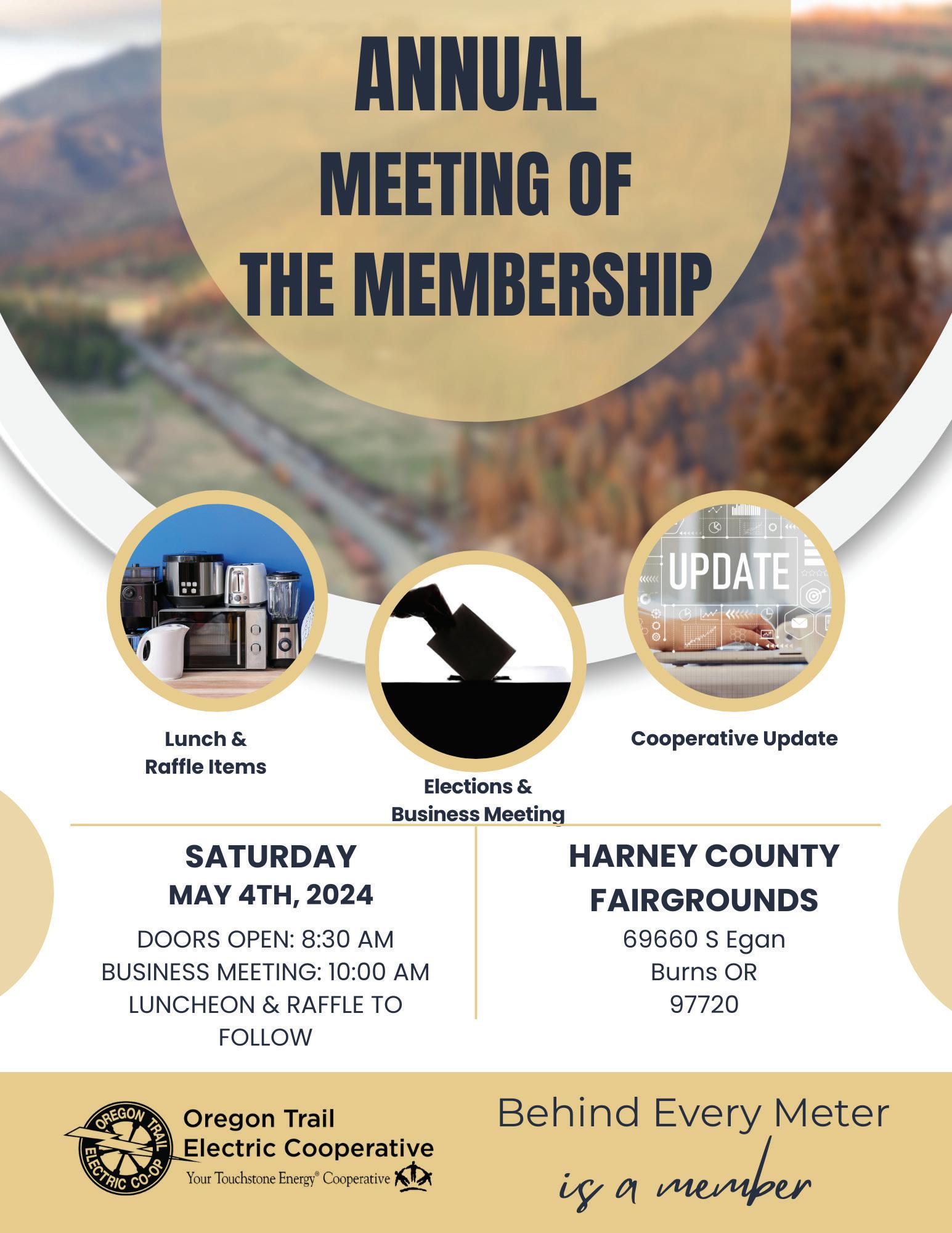
position 6. Since my appointment in October 2002, I have enjoyed the time spent on the board, and I feel I can meet the challenge and be a productive participant. Thirty years’ experience in the utility business has created the ability to make decisions that are best for the members and the employees of OTECC. One of the largest
factors in our economic future will be reliable electricity. We may have to investigate other means of providing that reliability at a reasonable cost. Regulatory and legislative solutions may be necessary to maintain the best service to our members. We are fortunate to be living in the Northwest where hydroelectric power has been a
reasonable source for our electricity, but who knows what the future will bring. We must be able to change and adapt with the times. I have been a member/owner of OTECC from its beginning and would be honored to continue to serve as director. I would appreciate your vote to be re-elected to this position. n
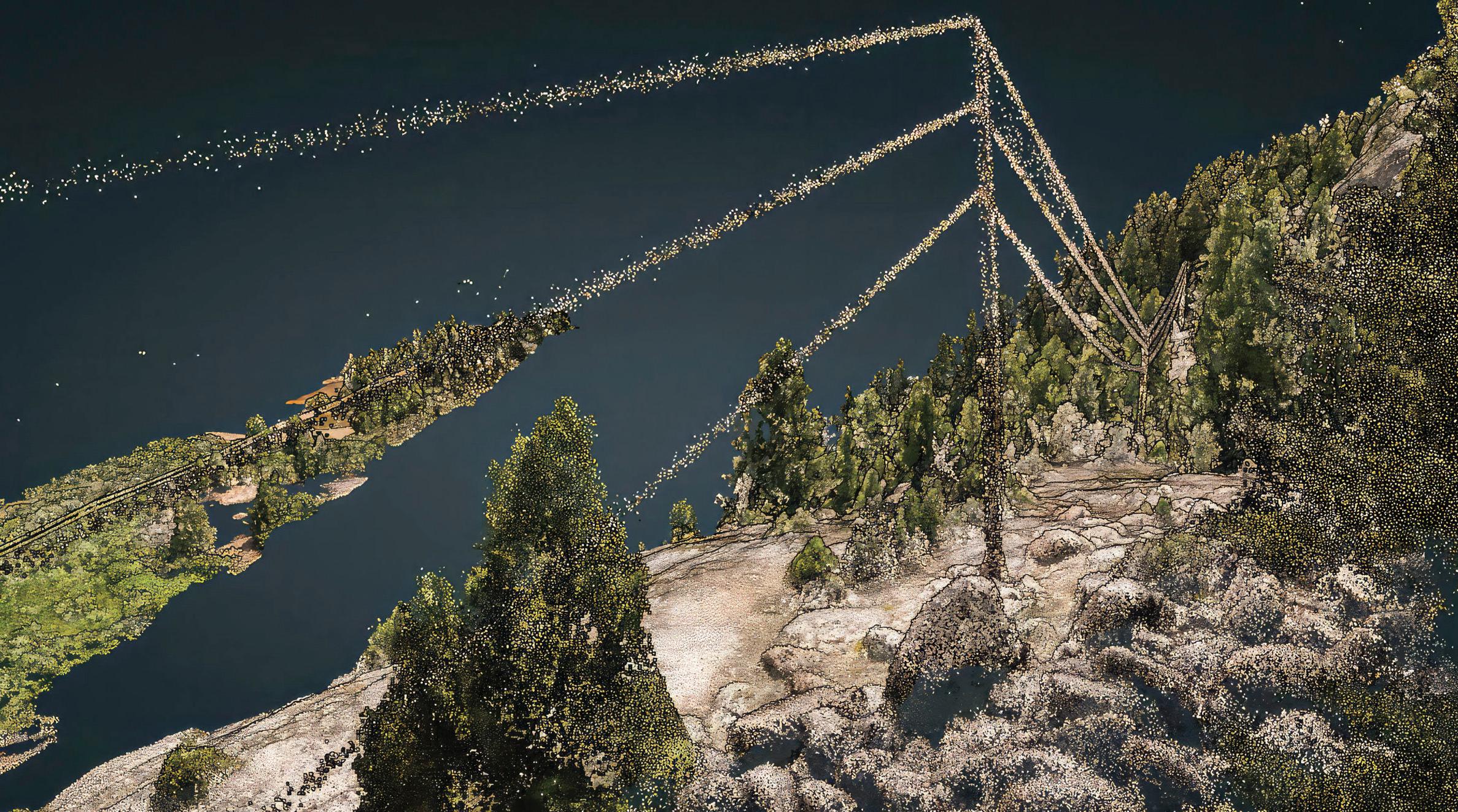
Staying a Step Ahead of Mother Nature
Electric utilities often rely on technology to manage vegetation
By Jennah Denney
Mother Nature tends to have a mind of her own. Utility power lines are vulnerable to damage from severe storms—particularly fallen trees and limbs, which can lead to power outages. About 50% of outages are caused by overgrown vegetation, which is why electric utilities regularly trim and maintain their local systems.
This starts with significant on-theground labor, including manual data collection, as workers assess the vegetation that needs to be cleared while walking below the infrastructure. Following the trim work, manual verification of its quality and completion is required.
This has been the standard approach for the past few decades. But as extreme weather events increase and digital tools improve, electric utilities are looking to innovative vegetation management methods to improve power reliability for consumers.
With the help of technology, utilities may be able to dispatch trimming crews at the ideal moment and location, preventing additional outages while enhancing productivity, cutting costs and providing better service.
Timely monitoring can help identify infrastructure susceptible to damage. Finding the right technology makes this process more efficient.
Each vegetation management tool has advantages.
Lidar—which stands for light detection and ranging—gives exact, 3D data about the shape of the surface around utility assets. Lidar is a popular way to scan portions of forests to determine the height of trees. The technology doesn’t generally assess plant health but can pair with highresolution multispectral satellite imagery to help define areas of need.
Satellites provide coverage 24 hours a day and can supply two kinds of images: a wide view of the area near utility assets
and a more detailed micro view. Satellite data can often be used in place of other monitoring methods.
With satellite technology, utilities can learn a lot about local vegetation, including:
• Health. Information gathered makes it possible to predict vegetation growth based on real conditions.
• Dryness. This information is valuable for determining the likelihood of a wildfire and how to protect utility infrastructure.
Satellites are always in orbit around the Earth, so data can be updated quickly, in real time. This makes it possible to respond swiftly and precisely.
Today, satellite images can have a spatial resolution to within 1.6 feet, making it easy to spot when vegetation grows in the rights-of-way near power lines and utility equipment.
Typically, satellites speed up the process of inspecting power lines because they provide information for making data-driven
Paired with satellite imagery, lidar technology—which stands for light detection and ranging—can collect detailed, beneficial data on large amounts of vegetation near power lines and other utility assets. PHOTO COURTESY OF SANGRE DE CRISTO ELECTRIC COOPERATIVE
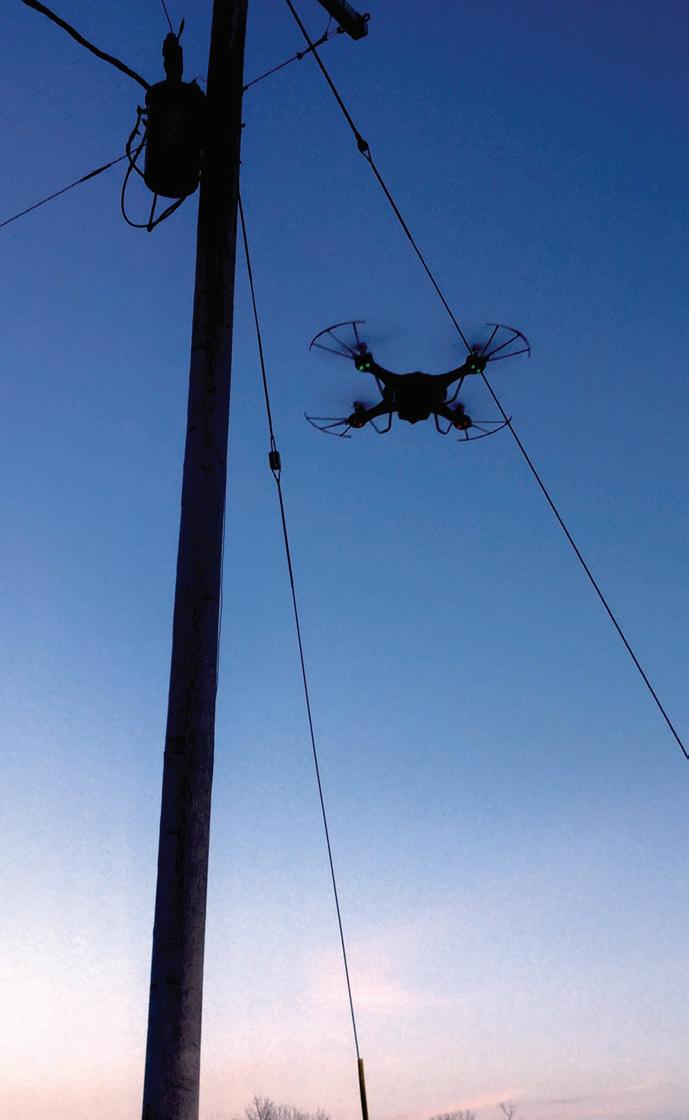
Think Ahead When Planting a Tree
By Scott Flood
“Why can’t they just leave my trees alone?”
Electric utilities are required to document that every piece of equipment and every foot of their power lines are a safe distance from trees and other vegetation. If a tree-trimming crew visited your home, it was likely because your trees were closer to power lines than the rules allow, and your electric utility is legally required to act.
Thinking about what’s above the ground is only part of tree-planting safety. Before you grab a shovel and start digging, contact 811 to make sure you won’t accidentally cut into any underground utility lines. The service sends people to your property to mark the approximate locations of utility lines. Because it can be challenging to pinpoint exact locations, use only hand tools when digging within a few feet of the markings.
decisions about vegetation management.
Electric utilities can also use fixed-wing aircraft and drones to monitor and control the growth of trees and plants near power lines. Drones fly close to equipment, take clear images and provide data to help show how close vegetation is to equipment and check the health of trees.
Many utilities use drones with cameras. When it comes to taking care of surrounding vegetation, drones are often used for detailed surveys rather than large-scale monitoring like satellites.
Once lidar or satellites—often together—have collected data on a large amount of vegetation near power lines, drones can be used to inspect a single area and do all the necessary checks.
Public power utilities place a high focus on vegetation management. It is the most crucial tool for reducing the likelihood of power outages. A thorough understanding of the vegetation’s past, present and projected future is essential for a successful approach to reducing these risks.
The growth of lidar, drone and satellite data presents an opportunity to close the loop with continual data-driven vegetation management intelligence and increase the power line system’s dependability and safety. In the end, all three technologies for managing vegetation serve different purposes, and electric utilities choose the options that work best for them. n
The last thing your utility wants to do is alter or remove a prized part of your landscaping. It would rather help you avoid conflict between electricity and greenery altogether. How? By reminding you to plant your new trees, shrubs or other vegetation where they won’t grow into power lines or other electric equipment. Whether you want to plant a tree, a decorative shrub or something else, it’s helpful to consider how it will grow during the next 20 or 30 years. Consider the eventual height and how wide the canopy of branches is likely to spread.
For example, even small trees and shrubs should be planted at least 20 feet from power lines. If you can’t plant that far away, make sure you choose a species that won’t top out at more than 15 feet high.
Trees that will be 40 feet high or less should be at least 25 feet from electricity. Larger trees should be at least 50 feet away.
Plant Trees Safely
Trees aren’t the only type of vegetation requiring thoughtful planting. If there’s a padmounted transformer in your yard, you might be tempted to hide it behind colorful flowers and neatly trimmed shrubs.
Unfortunately, if there’s a problem, crews need clear access to the transformer. That’s why it’s always a good idea to keep plantings at least 10 feet from the transformer’s doors and at least 4 feet from its sides. Otherwise, crews responding to a power problem may need to remove part of your landscaping.
Finally, if you notice your trees or other vegetation have grown dangerously close to power lines or equipment, don’t try to trim them on your own. Let your local electric utility know, or hire a professional arborist. Tree trimming is more dangerous than most people realize, and you don’t want to find yourself in an emergency room—or be the person who plunges your neighbors into the dark.
Drones can take clear images of electric infrastructure and provide data to monitor vegetation growth. PHOTO BY AMANDA JEAN FINNERTY









The answer: Although tremendous strides have been made in
cost reductions have not been






























If
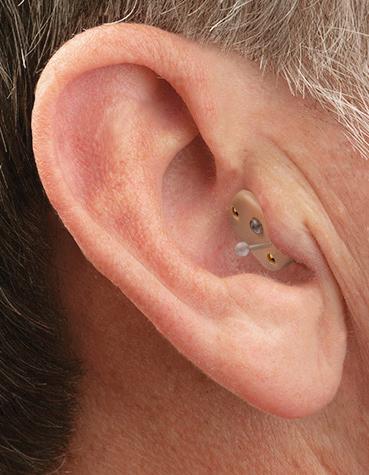









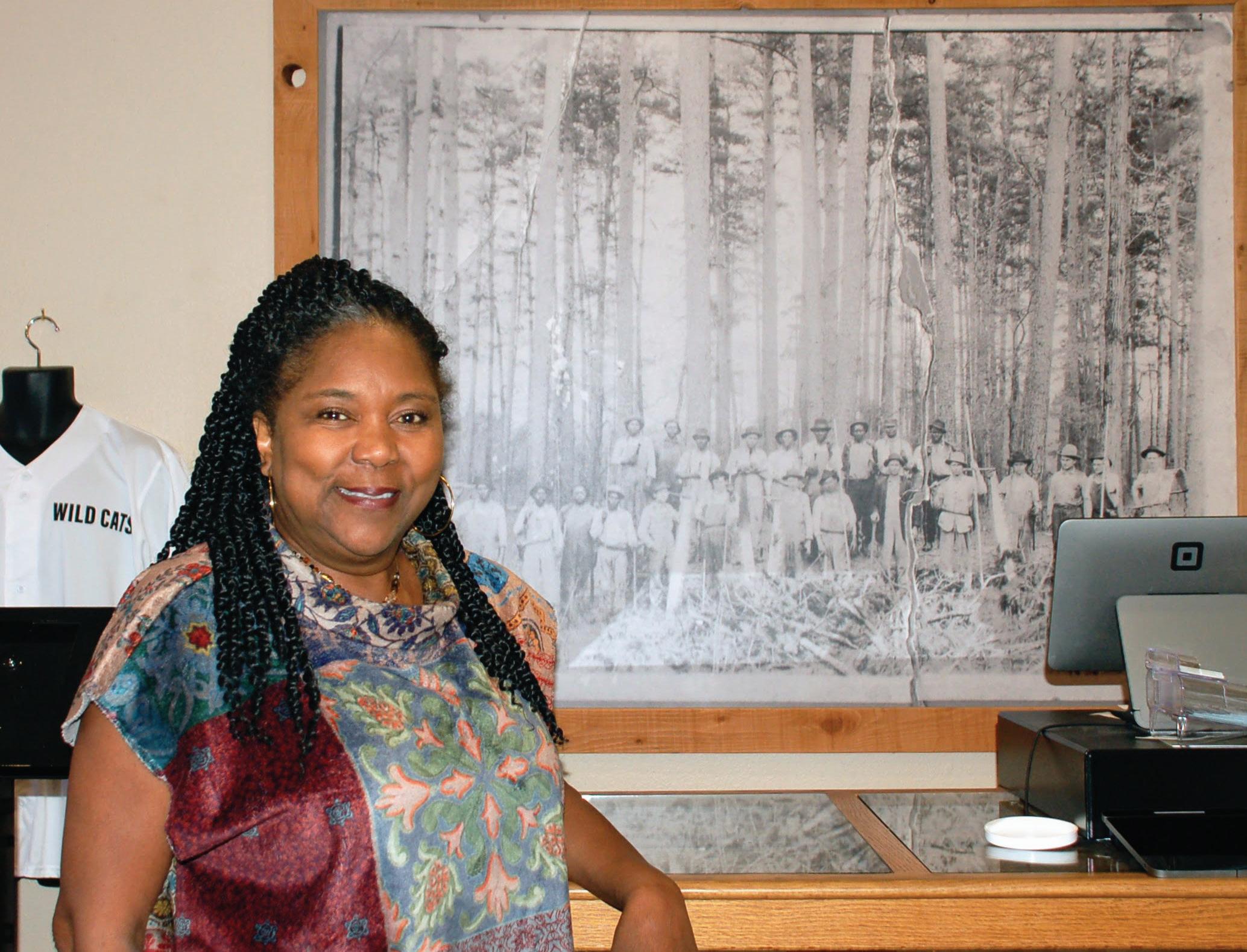
The documentary’s first Oregon viewing was at the senior center in Wallowa. There was an overwhelming turnout, surpassing the room’s capacity. Upon seeing the elders weeping in the front row, Gwen realized how important it was to tell the story of Maxville in its entirety.
“I knew that it was bigger than me coming back, writing on screenplays and doing my family history,” Gwen says. “It was a history of a community. I had no idea how much bigger it would get.”
100 Years of Maxville
Not many Oregonians have heard of Maxville. The town of about 400 people was founded in 1923 by the Bowman-Hicks Lumber Co., which recruited loggers from the South to work in the timber industry. Unlike most lumber towns, Black and white loggers worked side by side.
The segregated township was one of the only places in Oregon where Black families lived due to Oregon’s exclusionary laws at the time. Despite the laws and segregation practices, the town was known for breaking down the barriers of race. Gwen says community members relied on each other and coexisted peacefully.
“(Maxville) is a place where my family came because they got to make more money and had the hope of possibly coming out of a space that we were being hung from trees in the South,” she says.
For a decade, Maxville prospered as a major logging town. But in 1933, it fell victim to the Great Depression, and the land was quickly vacated. Many families moved to nearby Wallowa or La Grande. The history of the once-bustling community faded from memory during the next few decades.
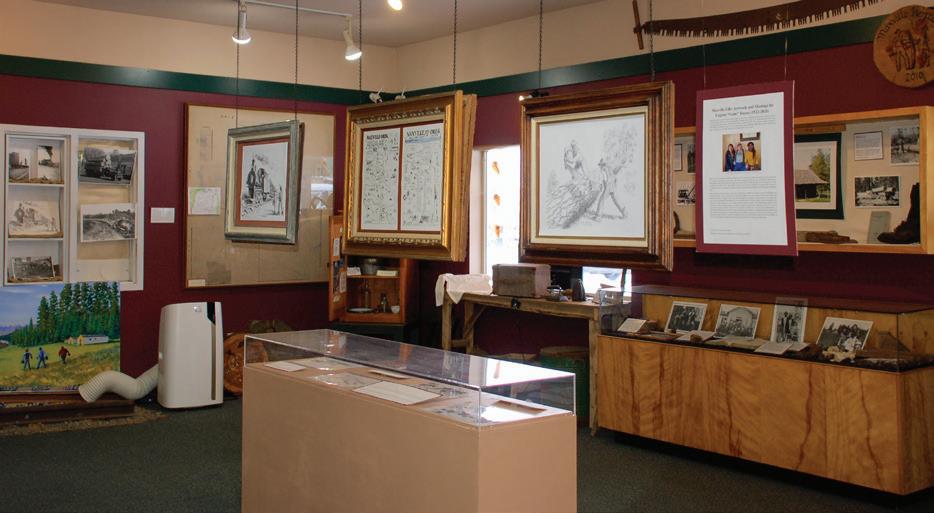
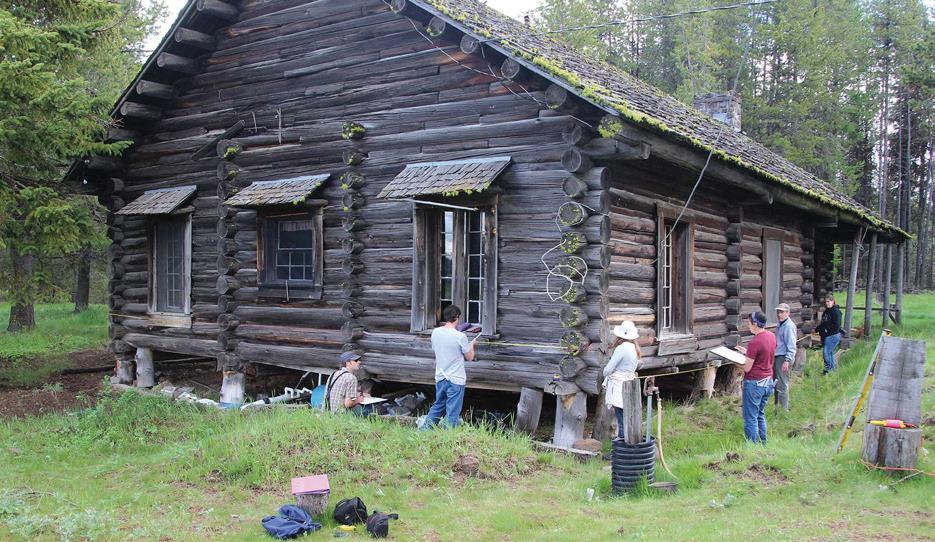
One hundred years later, Maxville is reentering the Oregon landscape thanks to Gwen’s efforts and advocacy. With the help of Hancock Timber, Eastern Oregon University and Clatsop Community College, Gwen is restoring the authentic cabin that remains on the townsite. She hopes to establish the site as a visitors center and permanent exhibition of the Maxville Heritage Interpretive Center.
Interpreting the History of Maxville
With her materials collected and the groundwork started, Gwen began to create the Maxville Heritage Interpretive Center in 2008. Since then, she has worked tirelessly to cultivate an educational and healing environment.
“To tell this inclusive story—the good, the bad, the ugly—in a truthful and transparent way is extremely healing and helpful,” Gwen says. “And it’s difficult. Some days are better than others.”
Gwen says the center is a healing place for not just for Black people but also allies.
“We’re creating a trauma and healing program right now,” she says. “Trauma and healing in the environment and making the connection to a lot of us that have been marginalized in one way or another.”
The program is in the early stages of development. As Gwen expands the center, she hopes visitors see it as a sacred and bright place for everyone.
“We all have different needs,” Gwen says. “But I hope that it provides a bridge to whatever healing they may be looking for.” n
Maxville Heritage Interpretive Center is at 103 N. Main St. in Joseph, Oregon.

CLOCKWISE FROM LEFT: Gwen stands proudly in front of a historic photo of the Black and white loggers from Maxville, where her father is pictured in the back row, fourth from the left. PHOTO BY CHIARA PROFENNA The interior of the Maxville Heritage Interpretive Center features a curated collection of photographs from Maxville, artistic renderings of the town and personal artifacts from families, painting a vivid portrait of life in Maxville. The historic Maxville cabin is being restored to create a new expansion for the center. Since the project began, the site has been nominated for the National Register of Historic Places. PHOTO COURTESY OF THE MAXVILLE HERITAGE INTERPRETIVE CENTER

Majestic M onarchs: Royalty Among
Pollinators
By Pamela A. Keene
ADOBE STOCK IMAGE BY BAZZIBA
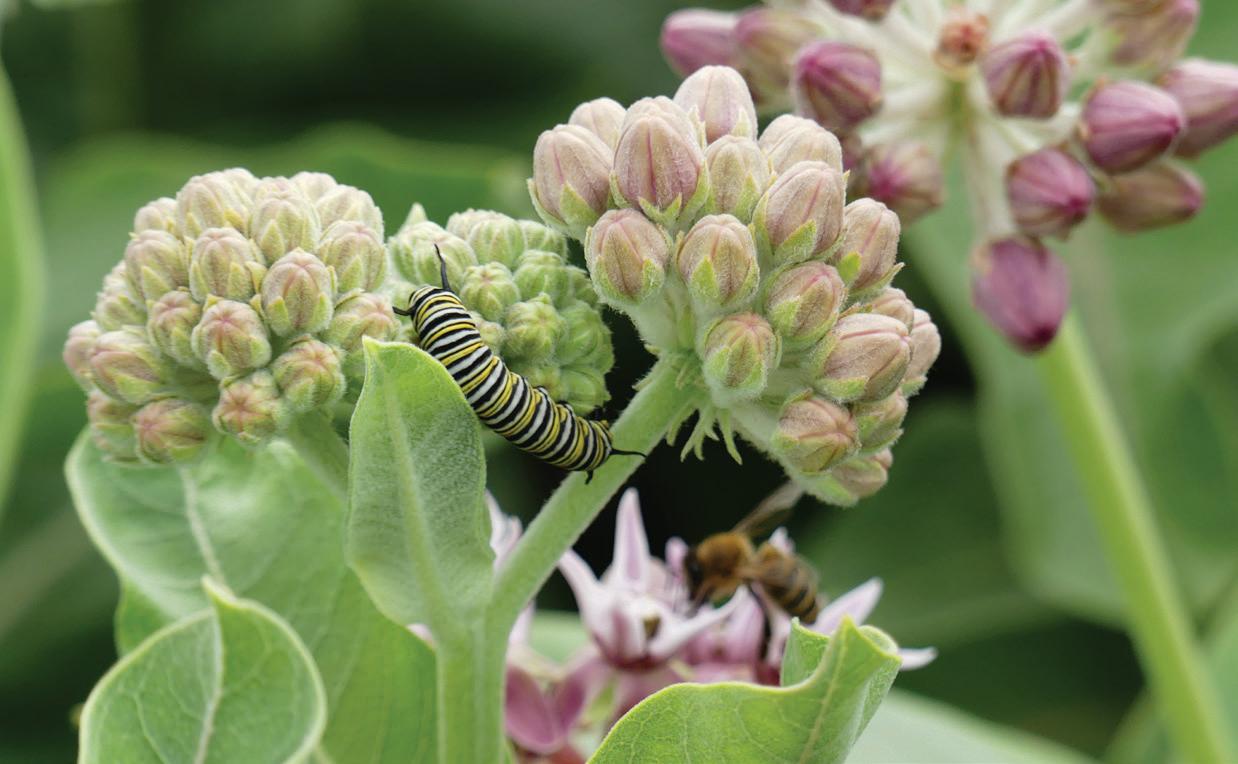

Pollinators in the Classroom

pollinator gardens at the school.
“In 2021, we began the garden program with two second grade classes, and the project has grown to six gardens maintained by three second grade and three fourth grade classes,” Julia says. “Each of the classes has time devoted to insects, and the gardens are filled with red ladybugs, praying mantis, earwigs and green lacewings, which feed on harmful bugs, such as aphids. Butterflies flit in and out and feed on the nectar of native plants.”
This year, Oregon State University graduate student Ashley Hall has joined the team as an intern for her environmental sciences thesis, focused on monarchs, including developing curriculum.
“Last September, Ashley was able to secure caterpillars for the students to raise and release after they morphed into butterflies,” Julia says. “Ashley also received a Bright Ideas grant from CoosCurry Electric Cooperative that was used to purchase educational supplies, butterfly enclosures, bug boxes and magnifying glasses.”
Community support also comes from Brookings Oregon Monarch Advocates, with master gardener volunteers as leaders.
Across the country, students participate in school gardening activities, growing fruits and vegetables, and studying the importance of pollinators.
In Brookings, Oregon, an original school garden from the early 2000s at Kalmiopsis Elementary School sees new life as a teaching tool. With a group of dedicated teachers, students and volunteers, students learn about where their food comes from and the vital roles of insects and other pollinators in feeding humans.
“Teaching youngsters about cultivating plants from an early age can help instill a love of gardening that will last them their whole lives,” says Julia Bott, who provides staff support for school programs through the Master Gardeners of Oregon State Extension.
Julia worked with volunteers and teachers to revive the
“The pollinator garden has become a focal point of our school and an educational complement to growing fruits, vegetables and flowers here,” Julia says. “At first, when some of the students saw a bug, they’d scream and take off running. Now, they’re learning about the benefits of insects and appreciate them more.”
Across North America, the profile of monarch butterflies and other pollinators is rising through environmental organizations, conservation groups and initiatives such as National Pollinator Week each June and the November Western Monarch Count.
“Helping preserve our pollinator habitats and protect these vital insects can be everyone’s mission,” Lora says. “Whether you volunteer for a community project, plant more natives in your landscape or put several perennials in a container on your deck or porch, you’re doing your part. Every little bit helps.” n
CLOCKWISE FROM TOP LEFT: A monarch caterpillar lives its entire life on milkweed. A tagged monarch visits its host plant, showy milkweed. PHOTOS BY STEPHANIE HAZEN A monarch butterfly emerges from its chrysalis.
PHOTO BY PIXABAY

Protecting Pollinators
Sends a Message
By Pamela A. Keene
Think about the possibilities. Electric utilities manage miles of transmission lines across the areas they serve. What if the land within those rights-of-way could create better food sources, shelter and protection for pollinators?
That’s exactly what the Bonneville Power Administration has done in Portland, Oregon’s Forest Park—one of the largest urban parks in the country—through a multiyear collaboration with Portland Parks and Recreation and Metro, a regional planning agency. By improving the land beneath power line rights-of-way in the 5,200acre park, about 67 acres of habitat now provide better nesting sites, shelter and food sources for pollinators.
Begun in 2016, the Forest Park project has increased pollinators along the rights-of-way while reducing the company’s maintenance costs. The initiative speaks to sustainability, environmental stewardship and community involvement.
“Pollinators are crucial to the environment and to the very food we eat,” says Nancy Wittpenn, BPA environmental protection specialist and a leader in BPA’s Pollinator Workgroup. “However, many people are not aware of the benefits butterflies, beetles, bees and other pollinators provide, so we wanted to involve our employees in education and activities to learn more.”
In 2018, the agency created its first Pollinator Workgroup.
“The Pollinator Workgroup formalized what some BPA staff had already been working on,” Nancy says. “Today, our Pollinator Workgroup has 20 or so members who plan events and activities for employees during National Pollinator Week, create educational opportunities and design hands-on projects to protect and support pollinators.”
Activities have included installing temporary mason bee houses at BPA facilities, promoting the weeklong National Pollinator Week each June and sponsoring speakers to educate BPA staff about the importance and benefits of pollinators.
Projects have included a monarch butterfly mapping program, native plant selection and advice for landscape design at BPA facilities, creating pollinator-friendly management best practices used by several groups within BPA, and partnerships to replicate the Forest Park model in other BPA rights-of-way.
In 2023, BPA received national recognition for its work in Forest Park through the Pollinator Electric Power Award from the North American Pollinator Protection Campaign. Nancy received the 2021
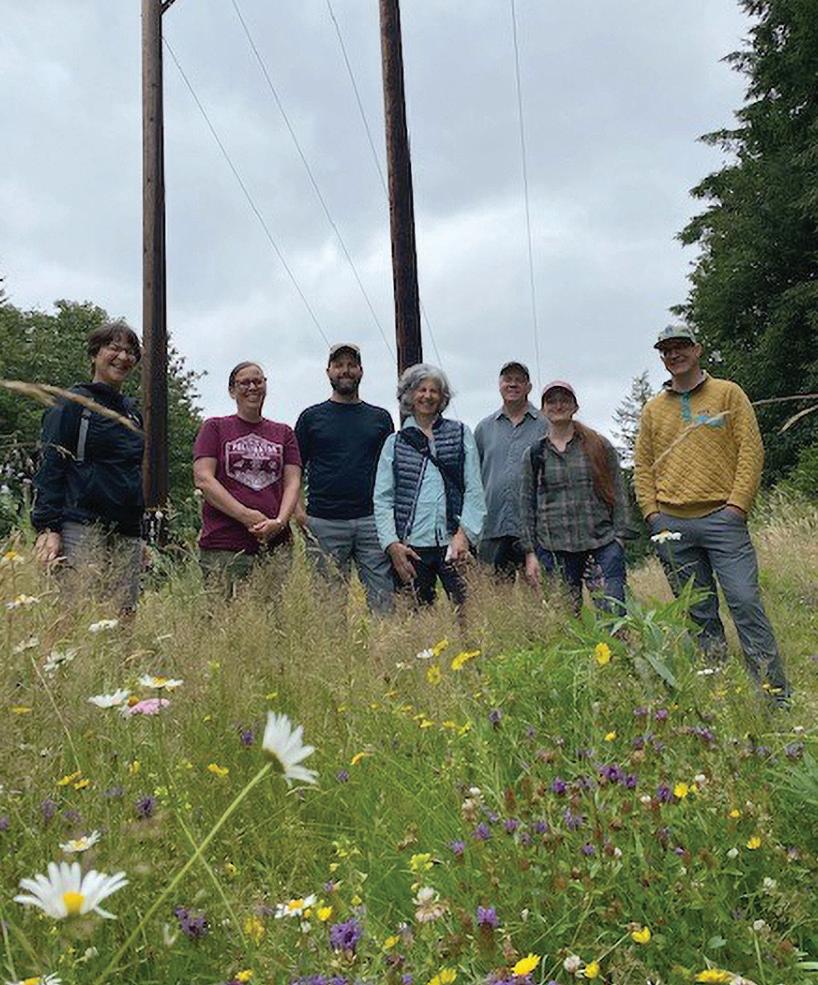
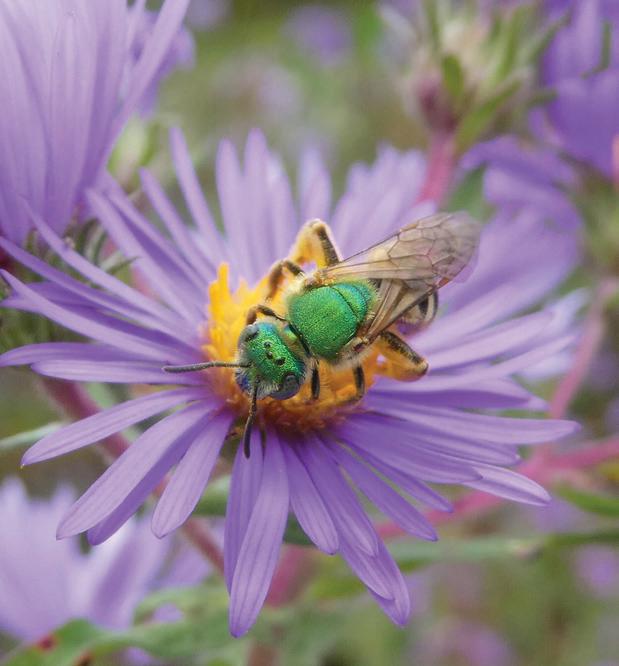
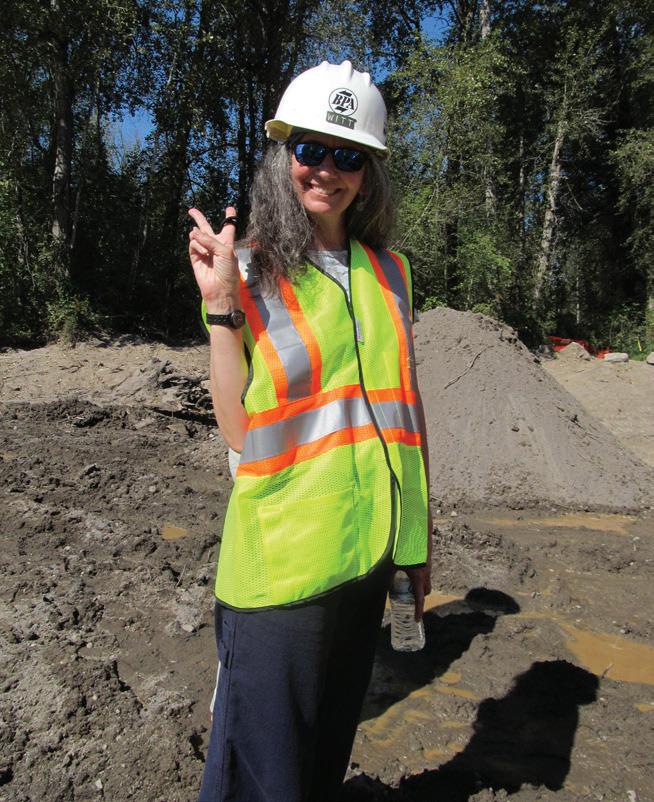
CLOCKWISE FROM TOP: The Bonneville Power Administration created a workgroup to organize and plan pollinator events. BPA's Nancy Wittpenn is an award-winning leader of BPA’s Pollinator Workgroup. Pollinators at work ensure our plants continue to flourish. PHOTOS COURTESY OF BONNEVILLE POWER ADMINISTRATION, AMBER BARNES AND POLLINATOR PARTNERSHIP
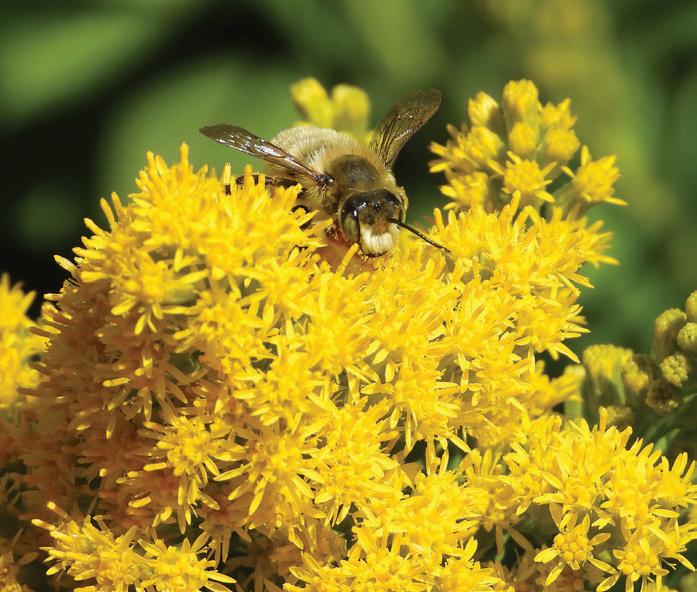
Power Delivery and Utilization Technology Transfer Award for her contributions to a documentary about pollinators. The Electric Power Research Institute produced the documentary as part of its Powerin-Pollinators initiative.
What has driven BPA’s commitment to pollinators?
“Our agency is in a very unique position to support pollinators while continuing to be effective environmental stewards,” Nancy says.
“BPA’s leadership and employees have made a commitment to pollinator survival, and this commitment has become an important part of our sustainability culture.
“We’re working within the organization, but many of our individual employees and their families are supporting pollinators in their own home landscapes and communities. It’s not only a win-win for BPA and the environment, but for the communities we serve, our customers and stakeholders, our employees and their families.”
Herbed Spanish Omelet
1 pound potatoes, peeled and diced or shredded
2 tablespoons extra-virgin olive oil
1/2 cup diced red onion
2 cloves garlic, minced
4 large whole eggs, lightly beaten
2 egg whites, lightly beaten
2 tablespoons finely chopped fresh parsley
2 tablespoons finely chopped fresh basil
2 tablespoons finely chopped fresh chives
Salt, to taste
Fresh parsley sprigs, for garnish
Place potatoes in a large pan. Cover with water. Bring to a boil and cook, uncovered, for 3 minutes. Remove from heat. Cover. Let stand for about 10 minutes or until potatoes are tender. Drain well.
Heat oil in a deep, 10-inch nonstick skillet over medium heat. Add onion and garlic. Cook for about 8 minutes, stirring occasionally. Add potatoes and cook for 5 minutes.
Combine whole eggs and egg whites. Stir in parsley, basil and chives. Season with salt, to taste. Pour mixture over potatoes in the hot skillet. Reduce heat and cook, uncovered, for about 10 minutes or until the bottom of the omelet is golden.
If desired, brown the top under a broiler. Garnish with fresh parsley sprigs.
Source: culinary.net
Breakfast Burrito
2 teaspoons canola oil
1 small red onion, diced
1 red bell pepper, seeded and diced
1 can black beans, drained and rinsed
1/4 teaspoon red pepper flakes
Salt, to taste
Pepper, to taste
4 eggs
4 egg whites
1/2 cup shredded pepper jack cheese
Nonstick cooking spray
4 flour tortillas
1/4 cup sour cream
1/4 cup salsa
1 large tomato, seeded and diced
1 avocado, sliced Hot sauce
In a large skillet, heat canola oil over medium heat. Add red onion and red bell pepper. Cook for 8 minutes. Add black beans and red pepper flakes. Cook for 3 minutes. Season with salt and pepper, to taste. Transfer to dish. In a medium bowl, whisk eggs and egg whites. Stir in cheese until combined. Heat a large skillet over low heat. Add egg mixture and scramble for 3 minutes or until cooked through.
Spread sour cream over the tortilla. Spread salsa over sour cream. Spoon 1/4 bean mixture over salsa. Spoon 1/4 scrambled eggs over the bean mixture. Top with diced tomatoes and avocado. Drizzle with hot sauce, if desired. Roll up burrito. Repeat three times with the remaining ingredients.
Source: culinary.net
Poblano Frittata
4 large eggs
1/4 cup fat-free milk
2 tablespoons chopped fresh cilantro
1 teaspoon olive oil
2 medium poblano peppers, seeds and ribs discarded, chopped
2 cups frozen corn, thawed
2 medium green onions, chopped
1/4 cup finely shredded cotija cheese or crumbled queso fresco
1 medium tomato, chopped
1/4 cup fat-free sour cream
In a medium bowl, whisk eggs, milk and cilantro. Heat oil in a medium skillet over medium heat, swirling to coat the bottom of the skillet. Cook poblano peppers for 3 minutes or until browning on edges, stirring frequently. Stir in corn and green onion. Reduce heat to mediumlow. Carefully pour in egg mixture. Cook, covered, for 10 minutes, or until the mixture is just set on the edges and still soft in the center. Avoid overcooking. Remove from heat. Sprinkle with cheese. Cut into eight wedges. Top with tomatoes and sour cream.
Source: American Heart Association
Sweet Potato Hash With Eggs
2 teaspoons canola oil
1/2 medium onion, chopped
4 medium sweet potatoes, peeled and cut into 1/2-inch cubes
1/2 medium red or green bell pepper, chopped
2/3 cup fat-free, low-sodium vegetable broth
2 teaspoons minced garlic
2 teaspoons smoked paprika
1 teaspoon ground cumin
1/2 teaspoon dried thyme, crumbled
1/2 teaspoon coarsely ground pepper
1/8 teaspoon salt
4 large eggs
Hot pepper sauce
Heat oil in an electric pressure cooker set on saute. Cook onion for 3 minutes or until soft, stirring frequently. Turn off the pressure cooker.
Stir in potatoes, bell pepper, broth, garlic, paprika, cumin, thyme, pepper and salt. Secure lid. Cook on high pressure for 3 minutes. Quickly release pressure. Turn off the pressure cooker.
Remove the pressure cooker lid. Crack one egg into a small bowl. Using the back of a spoon, make a small well in potatoes. Slip the egg into the well. Repeat with the remaining eggs, making separate wells for each egg. Secure the lid with the pressure vent open. Saute for 2 minutes. Let stand on the keep-warm setting for 2 minutes or until eggs are cooked to desired consistency.
Serve hash sprinkled with a dash of hot pepper sauce.
Source: American Heart Association
Books/Magazines
Looking to discover if anyone has old Robert Howard authored books (Conan and/or King Kull) for sale at a reasonable price. I will pay to ship. Thanks.
Mike Goodpaster
270 Old Stage Road Goldendale, WA 98620
Crafts/Hobbies
Senior citizen seeks to rekindle childhood love affair with stamps. I am looking for stamp collections: 1950s or earlier, U.S. or foreign, loose or in albums, and old envelopes and postcards with stamps, etc. Thank you.
Norman Allen P.O. Box 70 Janesville, CA 96114 woodsmit@psln.com
Hello! I live 50 miles from town, and I’m looking for buttons, especially old buttons. If you (or any family members) have any, I’d appreciate them deeply. Thank you very much.
Ana Howard 61380 Highway 129 Anatone, WA 99401
Looking for all things loom, yarns of any sorts. Plastic pegged looms, storage bags. Thank you in advance.
Tanya Dronoff
P.O. Box 270693 Susanville, CA 96127
Milestones
My aunt, Adrian Lisker, turns 100 this month. She worked at the Lower Westchester Y in Mount Vernon, New York, for more than 30 years. She helped several thousands of people with child care and other programs. She helped raise me as a child to be a kind and loving person and to help people in need. Please send her birthday cards to 312 Clairmont Ave., Mount Vernon, NY 10552. Thank you for helping my aunt celebrate this monumental event in her life.
Seth Goldstein Cannon Beach, Oregon
My Aunt Margaret will have her 90th birthday this month. I believe she would thoroughly enjoy and be very surprised to receive cards celebrating this milestone birthday. It would make her day very special. Thank you in advance for your consideration and generosity. Please send cards to Margaret McLaughlin, 401 NW Johns Lane, Pendleton, OR 97801.
Ron Kopp
Condon, Oregon
Odds
As the owner of the former Ochoco Grange Hall (#741) in Prineville, Oregon, I would dearly love to hear from anyone willing to share their personal experiences, knowledge and memories of this beautiful and historic property. It would be fun to learn more about the history of the property from people who have experienced it firsthand. Please include a phone number and/or email address. Thank you.
Rose Cribbs P.O. Box 175 Wallowa, OR 97885
Thanks
Irene Wolters, of Osburn, Idaho, turned 100 on October 31. Throughout October, she received more than 472 birthday cards. Irene expressed to me how much the cards meant to her and how happy they made her the whole month long. You just never realize what an impact you can make on someone’s life by just showing kindness and that they are not forgotten. Thank you so very much for the love and remembrance of my precious friend. May God bless you all.
Marilyn Burch Priest River, Idaho
Thank you so very much for all the wonderful buttons I received in the mail. It was such a surprise. I am still needing large red and orange buttons to make my daughter the octopus for her graduation.
Kim Koester Fairbanks, Alaska
I’m overwhelmed by the generosity and kindness shown by readers over the past six weeks in recognition of my 100th birthday. I not only received beautiful birthday cards, but also notification from agencies for contributions throughout the entire Western United States, as well as from New York City, Alaska and Hawaii. Many writers shared their life stories, and I read them as if I was catching up with a lifelong friend. Thank you ever so much for making my 100th birthday a true once-in-a-lifetime event.
Lorraine Martin Corvallis, Oregon
Happy Earth Day!
Submitting Requests Is Free
Send your request (no attachments) to readerexchange@ruralite.org or mail to Reader Exchange, 5625 NE Elam Young Parkway, Suite 100, Hillsboro, OR 97124. Fill in the subject line with Reader Exchange.
Acceptance, scheduling and editing are at the editor’s discretion. Single requests only, please. No duplicates.
Submissions are handled firstcome, first-served as space allows. We cannot honor every request.
Please affirm you have authorization from all appropriate parties before submitting. By submitting, you indemnify Reader Exchange, Pioneer Utility Resources Inc., its officers, directors, employees, utility clients and insurers from all legal liability incurred by the publication of information.
We no longer accept pen pal requests. You may submit a pen pal request as a Marketplace ad (pricing applies).
When submitting a milestone request, please send it at least two months before the milestone.
Phone numbers are not published. Email addresses are if they are part of the ad, but you must include a postal address.
Requests must include the name and address of the electric utility that provides your magazine.


& Jack B., CA A Better Way to hearTV®
“Now Jack can control the volume on his TV•Ears while I set the TV volume or mute it for complete quiet. Once again, he can understand every word and we can watch our favorite TV shows together.”
—
Darlene

Doctor recommended TV•Ears has helped millions of people with hearing loss enjoy their favorite television shows, movies and streaming content without disturbing others.
The Voice Clarifying Technology® reduces background noise and clarifies hard to hear television dialog making voices and words understandable. 120db of volume makes TV•Ears the most powerful television listening system on the market!
Quiet TV mode lets others mute the television or set the volume to their preferred level while you listen as loud as you want on the headset.

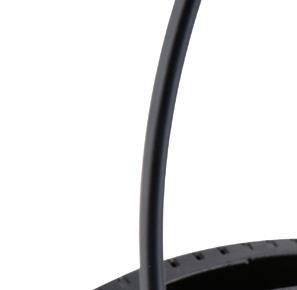
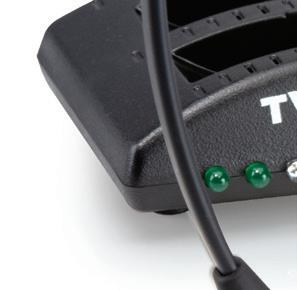








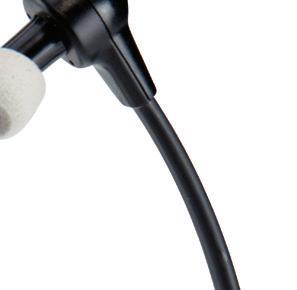





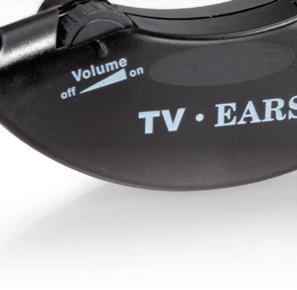












National Lineworker Appreciation Day Is April 18
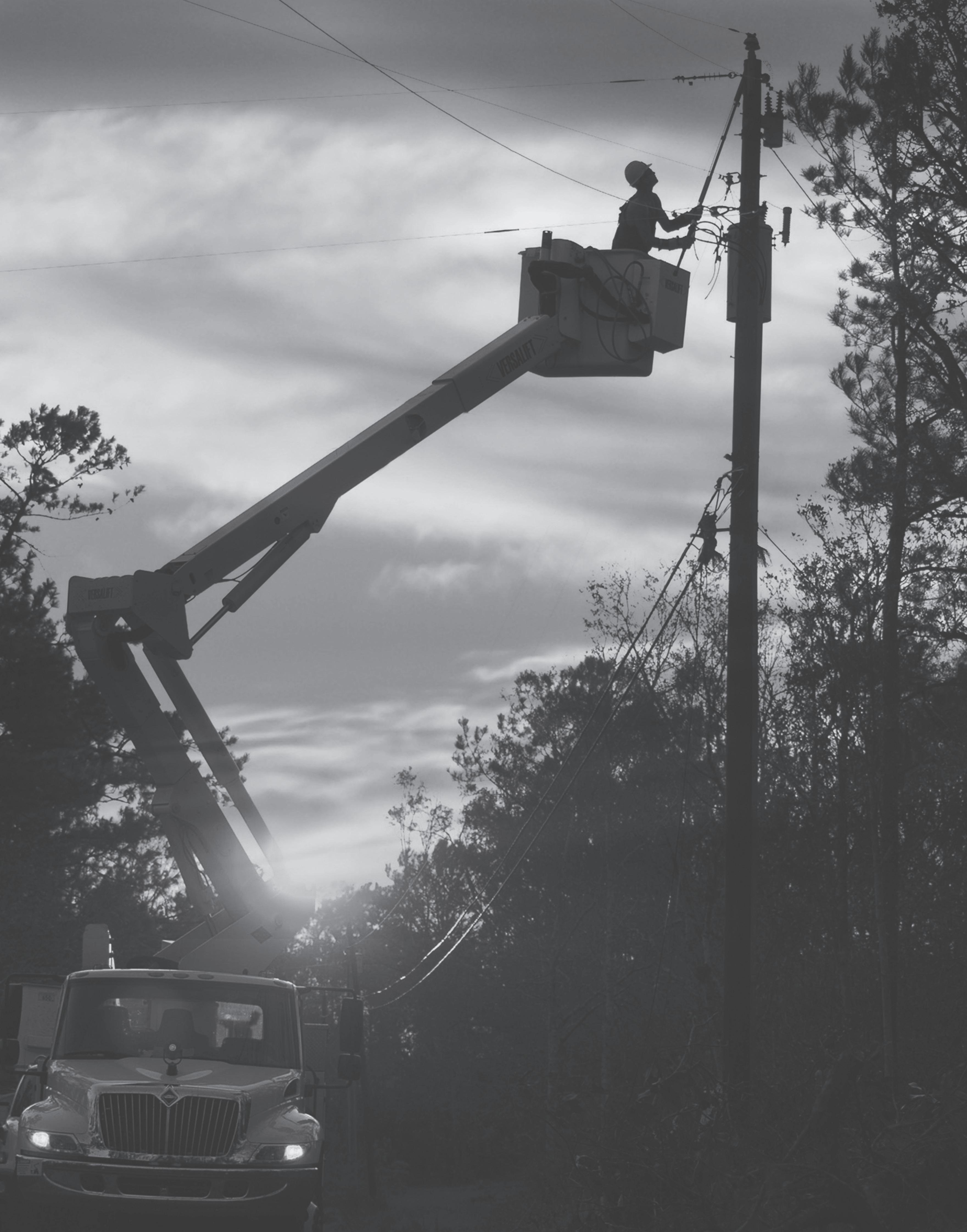
The United States power grid consists of millions of miles of power lines and associated equipment to bring electricity to homes and businesses across the country.
Oregon Trail Electric Cooperative serves nearly 60,000 residents—approximately 31,000 meters—with a network of overhead and underground lines more than 3,000 miles long.
Have you ever wondered who installs, maintains and repairs all that equipment? The brave men and women known as lineworkers toil day and night to keep the power flowing. If the power is on where you are reading this, you have a lineworker to thank.
National Lineworker Appreciation Day is April 18. Please join us in thanking these dedicated workers.
Here are some things you can do to help keep lineworkers and yourself safe:
• Before you dig, call 811 or go to Oregon811.com to have the location of underground utilities marked.
• When working outside, remember to look up. Be aware of your surroundings, including utility lines overhead.
• Keep utility poles clear. Attaching signs, birdhouses, fences and other items to poles is illegal and causes hazards when lineworkers need to climb poles for inspections and repairs.
• Hire qualified professionals to install generators or work on other electrical projects in your home. A generator installed incorrectly could be deadly to a lineworker during storm or outage restoration.
• If you see a downed power line, assume it is live. Do not approach it. Call 911 immediately.
Lineworkers have a dangerous and stressful job. Let’s all do our part to keep them safe. Thank you, lineworkers! n
OTEC Office Closure
All OTEC front offices are closed Thursday, April 11, for employee training. If you need to pay your bill, you can view your account, make payments, set up paperless billing and more on the free MyOTEC app. You may also pay your bill at the kiosks available at our OTEC offices or at otec.coop.
MARKETPLACE
Agriculture
Reinforced custom-sized pond liners (39 cents/sqft). Hay covers, greenhouse covers, any width and length. Truck tarps and more. High puncture and tear strength. Best price guaranteed. Celebrating 42 years in business. www.btlliners.com. 541-447-0712. 0424
4x5 round bales, Meadow Foxtail Orchard Grass. 4x4 Timothy, small square. 208-435-4637 or 208-435-4002; nas@cpcinternet.com. 1224
Antiques and Collectibles
Buying antiques and collectibles: advertising signs, porcelain signs, gas pumps, beer signs, antique toys, cast-iron coin banks, neon signs and more. Jason, 503-310-3321 or tjabaughman@yahoo.com. 0924
Buying American Indian collectibles, Navajo blankets and rugs, baskets, beadwork, etc. Also, quality paintings of the early Southwest and Americas. Call 760-409-3117 or send photos to amer.ind.baskets@gmail.com. 0524
WC Collectibles. We buy comic books! Local to the Inland Northwest, willing to travel. WCCollectiblesCheney@gmail.com; 509-496-1835. 0724
Boats
9-ft. fishcat pontoon boat. Anchor system, frame, motor mount, mesh cargo deck, oars, force fins, pumps, new condition. $600, cash. 541-963-8160. La Grande, OR. 0424
Books, Magazines, Videos
More “Montello Remembered” novels available. I’m also liquidating my NV history collection. Many rare and hard-to-find books now available. pruitt2010@frontier.com; 775-753-3254. 0524
Book restoration. Bibles, cookbooks, cherished family heirlooms. Beautiful work. We give renewed life, more durable than original, to last for generations. 775-537-7066; salacanstudio@gmail.com. 0424AR
Business Opportunities
Glass-blowing supplies and equipment. Includes: regulators, torch and multiple torch tips in various sizes, small oxygen tank. Bill, 406-827-7291 or shirbill@blackfoot.net. 0424
Quaint hardware store in Maupin, OR, for sale. Inventory and interior store recently updated and refreshed. See ad on Bizbuysell.com or email Maupincountrystore@gmail.com. $275K. 0924
Quick, Affordable: How to Place an Ad
Ads 25 words or fewer are $35 a month. An extended ad of up to 35 words is $50 a month. Contact information is included in the word count. Phone numbers and emails count as one word.
Longer ads may be placed. Contact 503-357-2105 or info@pioneer.coop for pricing information.
Ads are for customers of member co-ops, public utility districts and municipals only. Subscribers and nonmembers may inquire about pricing at 503-357-2105 or info@pioneer.coop.
Ads must be direct and in first person, and are subject to approval and editing.
Closing deadlines (in our office): June issue—April 30, 2024.
If submitting ad by mail, send appropriate payment with your name, address, email, phone number and the name of the electric utility that provides your magazine to: Marketplace, P.O. Box 1306, North Plains, OR 97133. Make check or money order payable to Ruralite.
We accept credit card payments for ads submitted by email. Send ad to info@pioneer.coop.
Call 503-357-2105 to pay by credit card.
Advertisements are accepted in good faith. Pioneer Utility Resources is not liable for interactions between buyers and sellers.
Community Events
June 21 and 22: 5th annual Ely Rock and Gem Swap. Buy-sell-trade. 10 a.m.-4 p.m. Presented by White Pine Public Museum, 2000 Aultman St., Ely, NV 89301. Entry fee: adults $7, children $4. Children’s activities and more. www.wpmuseum.org; 775-289-4710, wpmuseumnv@gmail.com. 0624
Annual Eastern Oregon University student art exhibit, plus work by artist Theresa Henderson. April 5-27, 2024. Art Center East in La Grande, OR. Artcentereast.org. 0424
Farm Equipment
Needed for AK homestead: Ford 601/2000, MF 35/135. 2 or 4WD, gas or diesel, live PTO, loader, power steering, ROPS or cab, wheel weights, ½ track kit. Ready for work haying airstrip/ski strip, snow removal. 8N needs help. 907-322-5846. Lower 48 OK. 0524
Free Items
Free materials—church, government uniting, suppressing “religious liberty,” enforcing National Sunday Law. Be informed. Need mailing address only. TBS, P.O. Box 374, Ellijay, GA 30540. tbsmads@yahoo.com; 888-211-1715.
Media
Watch local TV—on the go—for free on your TV, phone, tablet, computer or Roku. Visit www. kpvm.tv and stream live today! 775-727-9400.
Miscellaneous
Local commercial fisherman sells summer catch of preserved freshness by blast freezing at sea, gourmet canned tuna on internet. Sept.June. 100% guaranteed the best canned tuna you ever tasted. Original, jalapeno and garlic flavors available. Twofisherstuna.com. Call 206-799-1082 to place your order. 0624
Alaskan Yellow Cedar. Great for planter boxes, herb and flower beds, fencing or decks. Various sizes available. Pete, 541-206-0727. Lisa, 541-747-5025, ext. 21. 0624
Granite cemetery markers at affordable prices. Will ship to most places. For more info: www. highdesertmemorials.com; Joe, 541-815-8906 or highdesertmemorials@gmail.com.
Your ad could be here in June. See the opposite page for details.
Pets, Supplies
Purebred golden retriever puppies available in April. Parents are AKC registered, redcolored, short-haired, athletic, gentle, loving and superb companion animals. 541-390-3417. Sisters, OR. 0424
Choose your hunting companion now. Retriever puppies are half-lab/half-golden retriever. 541-620- 8039 or 541-620-8639. 0424
AKC/UKC health-tested rat terrier puppies. Chocolate and chocolate tri-colors. 1 female. 4 males. Ready now. Approximately 20 lbs. Litterbox trained. Kennel trained. House training in progress. Super smart. Even temperaments, on and off switch. 218-220-0699; Skinnersteadfamily@gmail.com. 0424
Looking for stud services for 2-year-old female borgi in late April-early May. Black and white borgi or miniature/small full-bred border collie preferred. Willing to pay a stud fee and travel if necessary. Suzi Smith, 775-233-7242 or suzicooksmith@outlook.com. 0424
Real Estate
40 acres in Christmas Valley, OR. Water well, metal barn 36’x36’, two open carports, one container. Send offers to 52485 Sunrise Blvd., La Pine, OR 97739. 0524
Lakefront home Eagle Lake, CA. 3-bd, 2-ba, 2-car garage, fully furnished and stocked, move-in ready, docks, boat lift. $299K or trade? 775-771-5263; bdl1962@gmail.com.
2-acre level lot with view. Well and power on-site with a nice mix of trees. On a paved road just minutes from Thompson Falls, MT, and the Clark Fork River. $195K. 406-923-8221.
$600K interior Alaskan turnkey roadhouse and 2 dry cabins. Well-maintained on 5 acres with pond. 50 scenic miles south to Denali Park entrance. 907-460-9292. 0524
Let me help you buy or sell ranch, farm and recreation property in Oregon. Fourthgeneration Oregonian. For sale Sisters, OR, 40 acres. Price reduced to $1,595,000. John Gill, 541-480-9161 or johngill@landandwildlife.com. Land And Wildlife brokerage. 0424
23 acres east of Cottage Grove, OR. 8 acres flat pasture, 15 acres forested hillside. 2 cabins, well, tractor, shed, firefighting equipment. City water, electricity. Quiet, secluded, views. Photos on request. $450K. hannond@comcast.net. 0424
Dayville Cafe. Be your own boss, located in the John Day Valley. $275K. Duke Warner Realty, 541-987-2363 or ddwr@ortelco.net. 0424
Columbia Gorge National Scenic Area, Dallesport, WA. 1,608-sqft. mobile home for sale in park. $670 monthly rent. Excellent condition. Professional upgrades. Motivated seller. $109K. 503-396-1251. 0424
4 well-maintained 1,200-sqft. cedar homes with huge decks on year-round creek. 2.12 acres. Close to small town of Selma, OR. $875K. 541-597-2185. 0424
Off-grid homestead. Ideal for wind/solar power. NE Elko County, NV. Has equipment, quarters, shop. Year-round access. Water and power nearby. $35K. geopup58@gmail.com. 0424
Recreational Rentals
Wavecatcher: oceanfront cottage. Central Oregon coast. Summer $175/night midMay to mid-Oct.; $140/night mid-Oct. to mid-May (plus cleaning/tax). Three bedrooms w/double beds. Pets welcome. Wavecatcherbeachrentals.com. Reservations: 541-740-2846. 0624AR
Bend country cabin. Very clean and fully furnished cabin on private ranch. Close to recreation areas. Very nice. $95/night. 541-382-3050; bendcountrycabins@gmail.com.
Vacation rental: Syringa, ID, rustic 2-bd. furnished frame cabin. Near rivers, mountains, wilderness. www.airbnb.com/rooms/356491; glenscott.swearingen@gmail.com.
Recreational Vehicle
Selling 2023 Forest River Salem FSX 17-ft. travel trailer 170SS with slideout. Like new, many functions never used. Call for more info/ price. 509-521-5074. 0424
Services
Dawn Till Dusk Masonry. Brick, block, stone and pavers. Small jobs and repairs welcome. Check out our website at dawntillduskconstructionmasonry.com. 541-388-7605 or 541-410-6945. License #245760, bonded and insured. LaPine, OR.
Call Pahrump Lock and Safe for all your residential, commercial and safe services. 24-hour emergency service in Pahrump, NV. 702-379-8441; Jim@pahrumplockandsafe.com.
We all want delicious, fresh, nourishing food to feed our families. We’ve got pastured pork corn/soy/GMO free. Delivery to your door or drop sites. Order at www.rural-roots-ranch. com or text Christy at 541-589-4674. 0724
Want to Buy
Old postage stamp albums. 253-307-1881; brashearsj@hotmail.com. Please send photos and contact info. 0524
Wanted: Small, working oven element for a 1967-ish flair, double wall oven. 15 inches long, including 3-prong plug-in, 10.5 inches wide. 541-256-0990. 0524
Buying American Indian collectibles, Navajo blankets and rugs, baskets, beadwork, etc. Also, quality paintings of the early Southwest and Americas. Call 760-409-3117 or send photos to amer.ind.baskets@gmail.com. 0524
Gold, silver, coins/currency, buy, sell. Collections wanted. Fair prices paid. 44 years in retail store. Baker City, OR. 800-556-2133; garrymclin@aol.com. 1024
Old carpenter tools, planes (wood/metal), levels, chisels, slicks, adzes, axes, hatchets, handsaws, old rulers, spoke shaves, wrenches, shipwright tools, old tool chests. 503-659-0009 or 971-666-0659. 0424
Need to buy one copy of “Morrow County History Book” in good condition, published in 1983. Hard cover, 9x11 1/4”, dark green with gold agricultural design inset on front. Ione, OR. 541-422-7495; L8ucy5T@gmail.com.
Wanted: early Corvette ’58-’62, any condition. Call/text Randy, 503-544-3807. 0824


The New Frontier
Great art has the ability to spark conversation
Story and photo by Hadley Marshall
The smell of crackling cedar filtered in from the fireplace in the other room. It was nearly spring, but outside, snow still lingered on the ground. Nearly 30 people gathered in the Hines Pine Mill House for a Cork and Canvas evening.
Chatter filled the room, and people poured themselves a beverage, taking their seats next to old friends and new acquaintances. For this evening, I selected a painting of two small bluebirds sitting on a pine branch.
Cork and Canvas events were a paid community art event organized by the owners of Mill House. Each month during my senior year of high school, I took an evening to become a teaching artist, leading a class of adults in an easygoing painting night when I would guide them in painting a particular picture.
At the time, I figured these evenings were just about teaching people art. But reflecting on these nights nearly four years later, I see that these evenings were full of enrichment, community and most importantly, joy.
The arts in frontier communities are a crucial part of people’s lives. Whether experiencing music, visual art, performance or any other medium, art fosters a community of growth. This growth comes in many forms, from the personal to the professional.
By connecting people to their roots, building community and bridging gaps among different types of people, art in frontier communities enriches the lives of those it touches and will continue to do so for decades to come.
When people think of art, they might picture “Mona Lisa” or “Starry Night.” It is assumed art usually falls into the high-brow category, and more often than not it feels inaccessible to the general public for monetary reasons.
The general public also assumes the art world is stuffy and overpriced, or is too involved with academia to be enjoyable. The theory is that great art exists in world-class galleries and museums, and these institutions alone. However, art is not defined by its
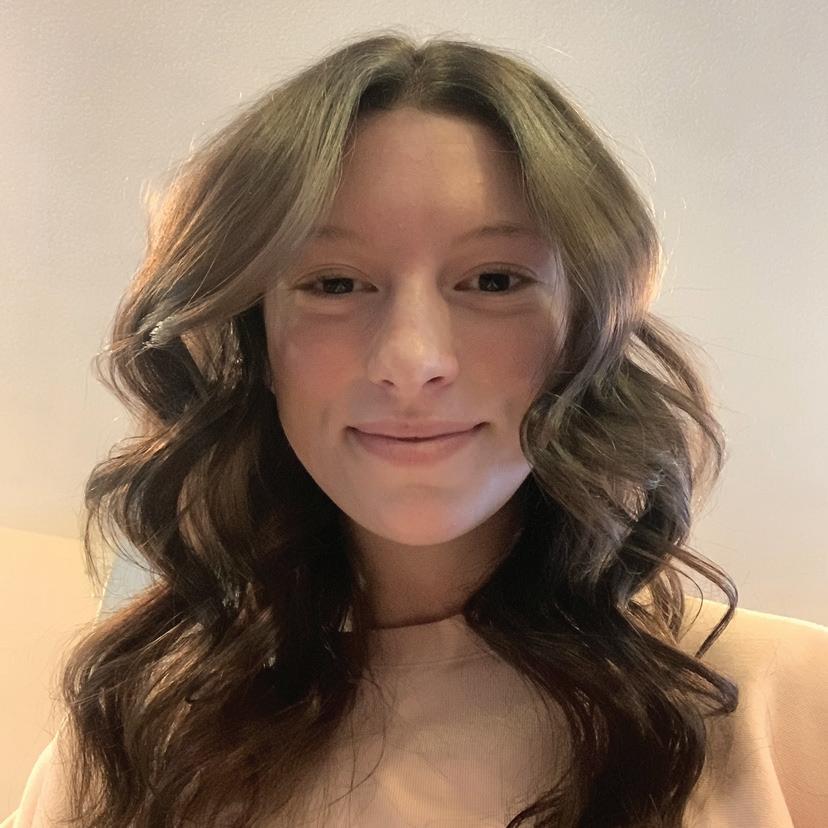

financial or intellectual success but rather by its ability to spark a conversation.
Frontier communities, as those who live in them know, are rich with conversation. I have lost count of the times I’ve walked into Grocery Outlet with my parents and have been stopped by at least three different people genuinely interested in how my family is doing.
When I was little, these were annoyances, as I was desperate to pull my parents away from whoever was talking with us and head into the chocolate aisle. But as I grew up, I realized these moments were key to building and fostering a healthy community through their ability to connect people.
Conversations about art are no exception.
Last summer, I worked with Art Center East in La Grande to finish my practicum for my art degree. Through this program, I was able to participate in Cove’s annual Cherry Fair, held the third weekend in August.
We drove to Cove just as the sun was rising, getting there early enough to set up our booth in hopes of beating the late summer heat. All around us, local artisans were also setting up their booths.
Canopies were erected, tables set up and totes full of
Hadley Marshall is an OTEC-EOU Rural Scholarship recipient and OTEC intern. She graduated from Burns High School in 2021 and is a junior at Eastern Oregon University.

of Art
About the Cover Artist
This month’s Ruralite cover features artwork by Gary Ernest Smith. Gary was born and raised on a cattle ranch in Medical Springs in Baker County. From an early age, his parents recognized and supported his artistic talent.
After serving his country, Gary began his journey to become one of the standard bearers of contemporary Western art. You may recognize one of his subjects’ faces or a scene in his art. Gary says he draws inspiration from the people and the land that raised him.
Crossroads Carnegie Art Center in Baker City is thrilled to welcome Gary this summer as he returns to Baker City to host his final retrospective event:“Towards Home: The Art of Gary Ernest Smith.” The event is May 24 through July 23 at 2020 Auburn Ave., Baker City.
wares unloaded from the beds of pickup trucks. After our booth was established with art activities for kids and adults, I decided to tour the rest of the grounds. As I meandered through the different artisans, I caught snippets of conversation from people doing the same thing as me: mothers with their toddlers, couples, many sets of grandparents, lively teenagers, college students, and two women playfully haggling over the price of a candle.
The artisans who participate in the Cherry Fair wouldn’t exist without the support of people, and people wouldn’t have a reason to meet without these artisans. It’s a mutual relationship. Its keystone component is conversation, whether that be about the goods or each other. Almost always, it’s both.
Art, as I mentioned earlier, does not always come in the form of a multimillion-dollar painting. More often than not, it’s simply the presence of something that is handmade, by somebody who genuinely cares about their craft. From bakers to blacksmiths, art gathers people.
This process of gathering people creates
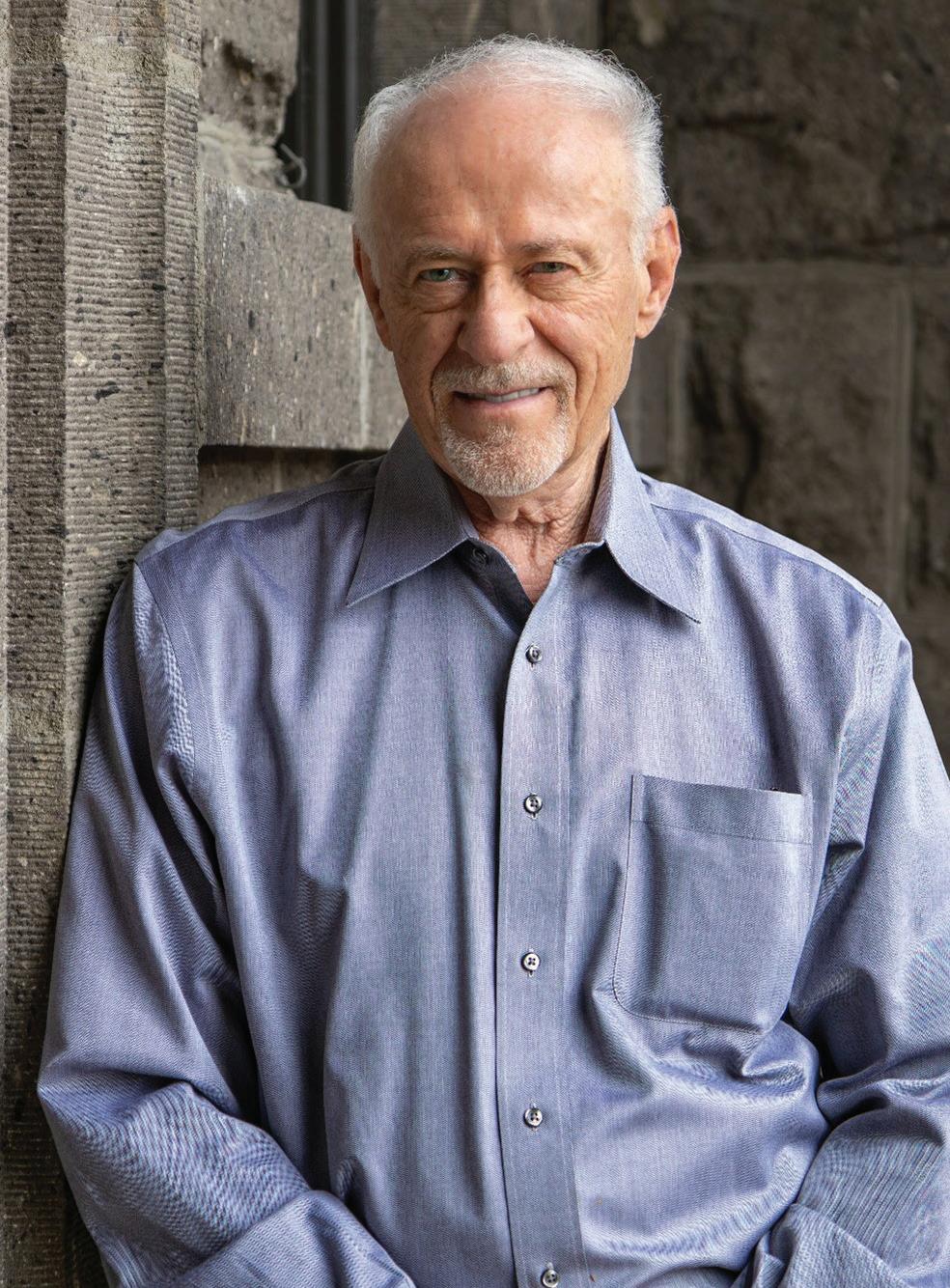
conversation, and this conversation creates community. As I’ve learned firsthand throughout my experiences with art in frontier spaces, artisans, artists and makers are crucial to the success of community enrichment, the fostering of growth and connecting people.
I’m preparing for my own group art show at Art Center East, with eight other emerging artists coming out of Eastern Oregon University’s art program. It’s been difficult, as any artist will tell you, but there’s one thing that’s keeping me going: community. The art show I’m about to put on wouldn’t be possible without the massive support from family, friends, peers, professors, parents and so many other loved and cherished members of Eastern Oregon, and the art that exists within this region.
From the cedar smoke of the Mill House to the summer heat of the Cherry Fair, art in frontier communities is the thing that connects people. So, the next time you’re in my hometown of Burns, stop by the Mill House and grab yourself a beverage.
You will discover a new piece of art and make a new friend. n
PHOTO COURTESY OF GARY ERNEST SMITH
BEFORE YOU GO Ruralite Readers Come Through
North Powder Charter School in North Powder, Oregon, is grateful to the generous Ruralite readers who sent decks of cards and dice to the school for Family Math Night in March. The request was published in a Reader Exchange ad in January.
The school received more than 400 decks of cards and 450 dice from across the United States, including places as far as New York City and Anchorage, Alaska. NPCS staff loved reading the personal notes enclosed with many of the packages.
The donations were used to make math game bags consisting of two decks of cards and a pair of dice. Students from preschool through sixth grade were invited with their families to enjoy a night of fun math games, dinner and bingo. Thirty-two families— more than 50 students—attended.
The math games build number identification skills and fluency with
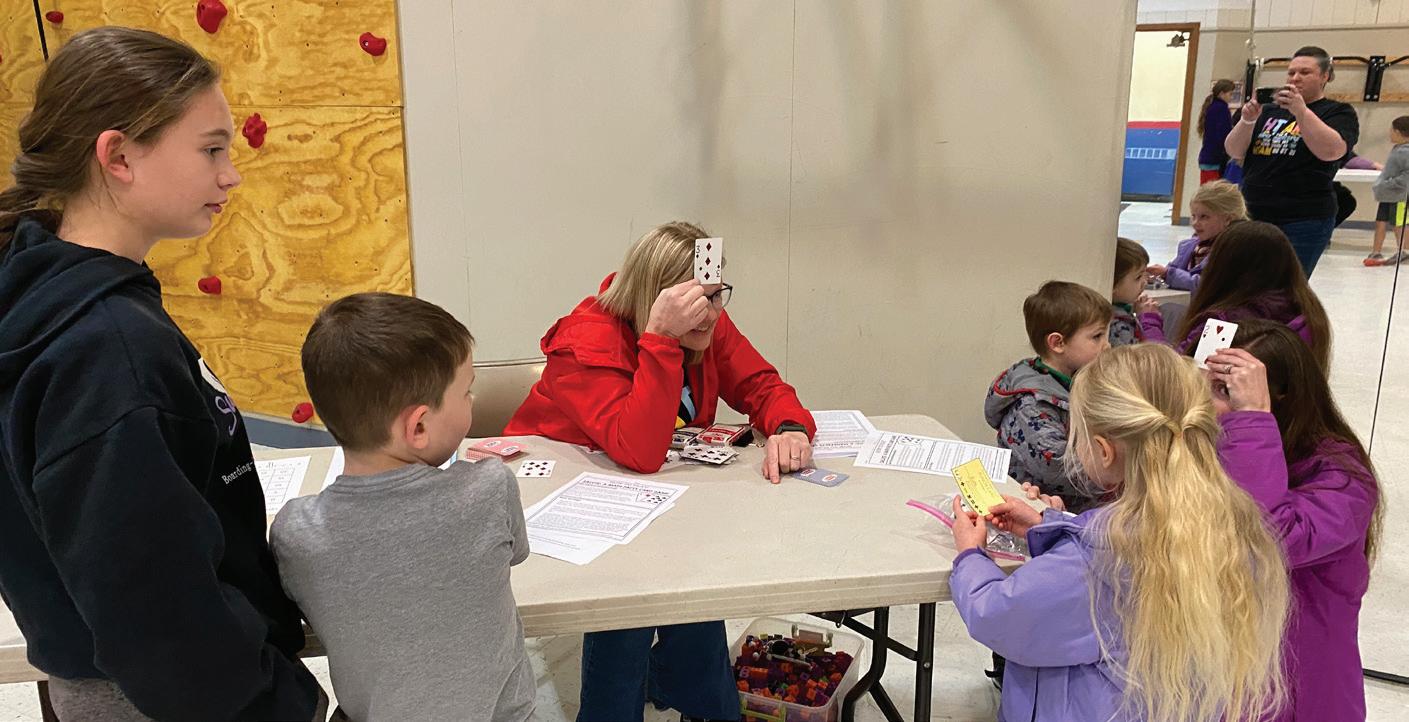
addition, subtraction, multiplication and division. Students took home their math game bags with directions for each game so they can continue to play with their families. n
• Powers up hills with ease

• Powered dumping
• Converts to a flatbed































• Bigger engines that chew up the competition

• Built USA tough for




















































Second grade teacher Dana Marlia plays salute with students and parents during Family Math Night at North Powder Charter School. PHOTO COURTESY OF NORTH POWDER CHARTER SCHOOL





























